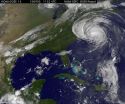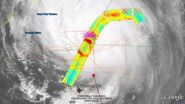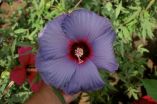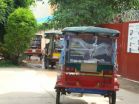Earth from space: Giant iceberg enters Nares Strait
2010-09-04
(Press-News.org) ESA's Envisat satellite has been tracking the progression of the giant iceberg that calved from Greenland's Petermann glacier on 4 August 2010. This animation shows that the iceberg, the largest in the northern hemisphere, is now entering Nares Strait – a stretch of water that connects the Lincoln Sea and Arctic Ocean with Baffin Bay.
The Petermann glacier in northern Greenland is one of the largest of the country's glaciers – and until August it had a 70 km tongue of floating ice extending out into the sea. The glacier regularly advances towards the sea at about 1 km per year.
Earlier this year, satellite images revealed that several cracks had appeared. Envisat radar images showed that the ice tongue was still intact on 3 August but, on 4 August, a huge chunk had detached.
Calvings from the Petermann glacier are quite common, but one of this magnitude is rare. Less significant events took place in 2001, in 2008 when a 27 sq km iceberg made its way south to Davis Strait, and in 2009.
This iceberg is about 30 km long and 15 km wide at its foot and almost 7 km wide at its head, covering an area of around 245 sq km. By 22 August this giant mass of ice had been carried about 22 km from its birth place.
On 1 September imagery showed that the iceberg had travelled almost another 6 km from the edge of the glacier and rotated westward (about 39°), just tipping into Nares Strait. The animation also shows that the iceberg hit a small island, which may delay further progression for a short while and may also cause the iceberg to break.
It is expected that the iceberg will soon be fully in Nares Strait, but its course depends on winds blowing off the glacier and currents in the strait, as well as sea ice that could block its path.
The animation was generated from 21 Envisat Advanced Synthetic Aperture Radar (ASAR) Wide Swath Mode (spatial resolution 150 m × 150 m) and three ASAR Image Mode (spatial resolution 30 m × 30 m) images.
INFORMATION:
[Attachments] See images for this press release:

ELSE PRESS RELEASES FROM THIS DATE:
2010-09-04
CAMDEN — One mention of E. coli conjures images of sickness and food poisoning, but the malevolent bacteria may also be the key to the future of renewable energy.
Desmond Lun, an associate professor of computer science at Rutgers University–Camden, is researching how to alter the genetic makeup of E. coli to produce biodiesel fuel derived from fatty acids.
"If we can engineer biological organisms to produce biodiesel fuels, we'll have a new way of storing and using energy," Lun says.
Creating renewable energy by making fuels, like making ethanol out of corn, has been ...
2010-09-04
Only about one in every six Americans who have ever been overweight or obese loses weight and maintains that loss, according to Penn State College of Medicine researchers.
While that number is larger than most weight-loss clinical trials report, the majority of Americans are still unable to lose weight and keep it off. Identifying those who lose weight and successfully maintain that loss may aid health professionals in developing approaches to help others maintain weight loss, the researchers say.
Two-thirds of the United States adult population is overweight, defined ...
2010-09-04
Ten years on, Martin McKee reflects on report placed health system performance rankings firmly on political agenda.
Martin McKee, Professor of European Health at the London School of Hygiene & Tropical Medicine has contributed one of three commentaries appearing today in the journal Health Policy and Planning, each of which take a different perspective on the World Health Report 2000 on health systems (WHR2000).
It is ten years since the publication of WHR2000, a controversial document which many at the time believed had been published prematurely, and which introduced ...
2010-09-04
Hurricane Earl lashed the North Carolina coast last night and this morning, September 3, and is now headed for Cape Cod, Massachusetts. This morning's image from the GOES-13 satellite saw Hurricane Earl's clouds covering most of the northeastern U.S.
The Geostationary Operational Environmental Satellite known as GOES-13 captured an image of Hurricane Earl at 7:32 a.m. EDT this morning, September 3. The image clearly showed a huge Hurricane Earl northeast of North Carolina with cloud cover stretching over the northeastern U.S. A disorganized Fiona was also seen southeast ...
2010-09-04
Hurricane Earl, currently a Category Two storm on the Saffir-Simpson scale with maximum sustained winds of 100 knots (115 miles per hour), continues to push relentlessly toward the U.S. East Coast, and NASA scientists, instruments and spacecraft are busy studying the storm from the air and space. Three NASA aircraft carrying 15 instruments are busy criss-crossing Earl as part of the agency's Genesis and Rapid Intensification Processes mission, or GRIP, which continues through Sept. 30. GRIP is designed to help improve our understanding of how hurricanes such as Earl form ...
2010-09-04
VERNON -- Dr. Dariusz Malinowski is seeing blue, and he is very excited.
For four years, Malinowski, an AgriLife Research plant physiologist and forage agronomist in Vernon, has been working with collaborators Steve Brown of the Texas Foundation Seed and Dr. William Pinchak and Shane Martin with AgriLife Research on a winter-hardy hibiscus breeding project.
The project was first a private hobby of the inventors and became a part of the strategic plan of the Texas AgriLife Research and Extension Center at Vernon in 2009. The flower commercialization is a part ...
2010-09-04
Researchers at Queen's University have found that people with Parkinson's disease can perform automated tasks better than people without the disease, but have significant difficulty switching from easy to hard tasks. The findings are a step towards understanding the aspects of the illness that affect the brain's ability to function on a cognitive level.
"We often think of Parkinson's disease as being a disorder of motor function," says Douglas Munoz, director of the Queen's Centre for Neuroscience Studies and a Canada Research Chair in Neuroscience. "But the issue is ...
2010-09-04
While vultures across Asia teeter on the brink of extinction, the vultures of Cambodia are increasing in number, providing a beacon of hope for these threatened scavengers, according to the Wildlife Conservation Society (WCS) and other members of the Cambodia Vulture Conservation Project.
Researchers report that record numbers of vultures have been counted in Cambodia's annual vulture census, with 296 birds of three species found at multiple sites across the Northern and Eastern Plains of Cambodia by the Cambodia Vulture Conservation Project, a partnership of conservationists ...
2010-09-04
Afla-Guard®, a biological control used to thwart the growth of fungi on peanuts, can be used on corn as well, according to a study by U.S. Department of Agriculture (USDA) scientists who helped develop it.
After extensive study and research trials in Texas, Afla-Guard® was registered by the U.S. Environmental Protection Agency (EPA) for use on corn, beginning with the 2009 crop.
Recently retired Agricultural Research Service (ARS) microbiologist Joe Dorner at the National Peanut Research Laboratory in Dawson, Ga., helped develop Afla-Guard®, a biological control for ...
2010-09-04
The modern world -- with its ubiquitous electronic devices and electrical power -- can trace its lineage directly to the discovery, less than two centuries ago, of the link between electricity and magnetism. But while engineers have harnessed electromagnetic forces on a global scale, physicists still struggle to describe the dance between electrons that creates magnetic fields.
Two theoretical physicists from Rice University are reporting initial success in that area in a new paper in the Proceedings of the National Academy of Sciences. Their new conceptual model, which ...
LAST 30 PRESS RELEASES:
[Press-News.org] Earth from space: Giant iceberg enters Nares Strait




